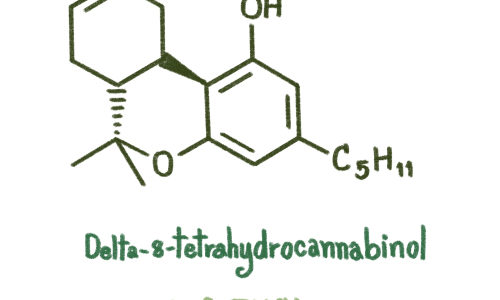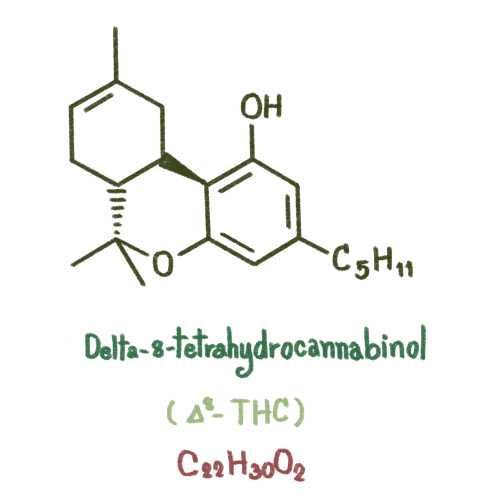Are Experts’ Warnings About Delta-8 Really Being Heeded by States?
Marijuana Industry NewsMarylandUtah January 19, 2023 MJ Shareholders 0


A report released last week recommending the regulation of “hemp-derived non-delta–9–Tetrahydrocannabinol products” in Maryland would seem to be a good thing. It’s issuance is already being characterized as a call-to-action for the legislature to act. The 134-page report by the Maryland Medical Cannabis Commission is certainly comprehensive in scope. The panel that wrote it monitored the experience of other states with hemp-derived products, engaged with industry stakeholders, and analyzed delta-8 products that were commercially available in Maryland. The report concludes with a handful of recommendations that prioritize testing for heavy metals and other contaminants, requiring warning labels listing ingredients and manufacturers to comply with FDA-approved CGMP guidelines, and the substantiation of therapeutic claims, among others.
On its face, then, Maryland would seem to be moving in the right direction, away from utterly untested products and toward public safety and the recognition that a serious problem needs to be addressed. Likewise, the Utah legislature, which began its 45-day 2023 session this week, begins its work with three cannabis-related bills under consideration, including SB 91, which adds the term “artificially derived cannabinoid” to a list of adulterants to be tested for by labs and then listed on labels by manufacturers. That bill also gives the appearance that Utah, like Maryland, is finally addressing a problem that has been staring it in the face for months if not years.
But appearances can be deceiving. According to longtime advocates for more cautious (i.e., responsible) approaches to handling delta-8 and similar products, neither state is acting responsibly. To the contrary, Christopher Hudalla, President and Chief Science Officer of Milford, Massachusetts-based ProVerde Laboratories, replied to a request for comment with a terse, “What Maryland has done is just utter irresponsible ridiculousness,” and then explained why.
Hudalla and others have been warning about the dangers of these products for years, working tirelessly to educate state regulators and the industry about the risks that come with allowing them onto the market without sufficient safeguards, or at all. He is not alone among scientists in that regard. In a letter dated September 27, 2022, sent in support of lobbying efforts by Christine Stenquist of TRUCE Utah, Dr. Ethan Russo concluded his entreaty, “It is my formal professional opinion that all cannabis-based products sold in Utah and elsewhere should be accompanied by a certificate-of-analysis (COA) on each batch of material, and that no synthetic cannabinoids should be endorsed for commerce by any state agency.” [Italics added]
Hudalla described his own evolution on the subject in an email exchange last month. “We started ProVerde Laboratories in 2013 as one of the first ISO 17025 accredited cannabis testing laboratories focused on ensuring consumer safety,” he said. “Over the last 9 years, we have provided analytical testing services for the Massachusetts regulated marijuana market, the global unregulated hemp market, and we also provide services for patients and home growers. Through those years, I believe we have seen the best of the best products produced, but also the worst of the worst in the cannabis markets.
“We have tested well over 100,000 samples to the point where I can almost recognize the chromatographic results with my eyes closed,” he added. “In 2019, we started noticing changes to our data, signals in our analyses that we had never seen before. Back in those days, with no idea what the nature of those signals was, there was nothing we could add to our report on our Certificates of Analysis (COAs). But the prevalence of these unknown signals grew, both in frequency and in magnitude. Being fairly academic minded, we have been investigating those signals, working with our clients, and collaborating with other researchers to understand what was giving rise to these signals we had not seen previously.”
What he found shocked him. “What we have learned over the last 3 years amounts to what I consider one of the biggest consumer fraud cases in US history,” he said. “Using an unintended loophole in the most recent Farm Bill, producers have been creating synthetic cannabinoids with no regulation or oversight.”
The problem is in fact rather simply explained. “Synthetic cannabinoids are by definition chemical compounds created through a chemical process by human agency, as opposed to those of natural origin,” wrote Hudalla. “These compounds can be synthesized to imitate a natural product (e.g. D9-THC), or they can be synthesized to create a compound not found naturally (e.g. D 9-THCPO). They can be intentional or accidental in their creation. I am not necessarily opposed to synthetic cannabinoids. However, the processes used currently are dirty processes and yield resulting products that are FULL of unnatural isomers, synthetic byproducts, and residual processing reagents. It is these unknown, untested compounds and contaminants that pose the greatest risk to consumers.”
The scale of the problem is daunting. “We have tested thousands of synthetic samples and have not yet seen one without these contaminants,” stated Hudalla. “It is not uncommon for us to see up to 20 different contaminants, in concentrations in excess of 30 or 40 percent of the cannabinoid content. These chemical compounds are unknown in toxicity, never have been tested for safety, never been tested on rats. And yet, the industry is using human subjects as guinea pigs to test out these novel compounds.”
Not all of the guinea pigs are faring well. According to Hudalla, “There have been thousands of adverse events reported to the CDC, and even some fatalities associated with these products. I cannot think of another industry, certainly in the US, that would permit such an irresponsible activity.”
The federal government has been asleep at the wheel. “Even though there has been significant evidence presented for concern, the FDA has so far refused to step in, and the DEA gave the industry the green light to move forward by declaring anything produced from hemp to be exempt from the Control Substance Act,” noted Hudalla, adding, “The courts have been siding with synthetic producers, so most law enforcement won’t even waste their time shutting down these operations. We see state by state, the regulators trying to wrestle with this issue, but regulators are often more concerned with how a ban would harm producers, rather than worried about consumer safety.”
Maryland
Fast forward to the recent news out of Maryland and Utah, as well as analysis from Brightfield Group citing over $2 billion in delta-8 sales over two years. I queried Hudalla for comment about these developments and asked if any of his concerns had been ameliorated. They had not.
“First of all,” said Hudalla, responding to the delta-8 sales number, “after discussing with many people that are actually producing and selling these products, the $2 billion is way understated. The true market size realistically is more like $5 billion or more. Keep in mind that many of these producers to not record, disclose, track, or report their sales, so it is very difficult to estimate. But from my sources, based on their actual sales, $5 billion is closer to the true market size.”
The situation in Maryland is simply unacceptable, he added. “We know a lot about these products, how many and the level of contaminants are in them,” he stated. “So, when I sit in on regulatory discussions, and hear the regulators say they will just make the labs test these products better, I just shutter. As if it was just that easy. Maryland has done the same thing, trying to put the public at ease by saying, ‘We’ll make labs test for contaminants in these products.’ What does that mean? I am a PhD analytical chemist with more than 35 years of academic and industrial experience, and I still do not know what that means.”
Hudalla continued, “There are so many contaminants in these products that it requires very sophisticated, and expensive instrumentation to test these appropriately. So, when the State of Maryland did their testing evaluation, between academic and commercial cannabis labs, I can tell you that the data collected is not worth the paper they were printed on…or their digital footprint. In their list of contaminants tested for (Appendix E), I did not see one mention of their residual toxic caustic processing reagents, the heavy metals from their catalysts, or the synthetic byproducts produced. They are testing for contaminants associated with cannabis, but this is no longer a cannabis product, so testing for cannabis contaminants is not appropriate. This is a synthetic chemistry product, so one would think you would be looking for the contaminants associated with synthetic chemistry processes, not those associated with agricultural cannabis.”
And the problem also extends to the state of testing generally, he added. “Most labs are still using HPLC for testing these products.” said Hudalla. “We know that HPLC ‘hides’ contaminants behind the Delta-8-THC signal, leading to overestimation on the purity of these products. A more representative evaluation of these samples will require the application of multiple orthogonal technologies to resolve all of the contaminants.
“We currently use a combination of HPLC, GC and SFC, and Mass Spec for the analysis of these products, and we still struggle with it,” he emphasized. “We can see many of the contaminants, but because we can’t always identify them, and it is hard to call them out. But the regulators say, ‘If you can’t identify them, then how do you know they are there? How do you know they are dangerous?’ They feel that if we have not collected a history of them being dangerous, that must mean they are okay.”
To make his point, Hudalla employed an analogy. “Suppose you come home from a night on the town, and you find that your house was broken into,” he said. “The door is ajar, the window is broken, there are three sets of footprints throughout your house, a couple of sets of fingerprints, and your TV, stereo, jewelry, and money are gone. The police are called, and they collect the fingerprint samples, take photographs of the footprints, and they run the data through their fingerprint database and find no hits.
“Does that mean your house wasn’t broken into,” he asked rhetorically. “Just because you can’t identify them, does it mean they were not there, or that they are not dangerous? The facts are, you know they were there, you don’t know who they are, and you don’t know if they are dangerous or not. And these regulators want to invite them all over for a dinner party or see if they’re available to babysit the children. It just doesn’t make sense to me.”
Not surprisingly, new synthetics appear to be multiplying exponentially, said Hudalla. “It seems that new synthetic products are hitting the market every week,” he said. “Somebody asked me for a list of the synthetic products that could be produced, and while these are not all commercially produced in the market, I started to try and imagine all the variants that could be out there. I could not even finish all the permutations when I got frustrated at the futility of trying to understand all this. The most recent ones I have heard of are THCX (which is actually a mixture of esterified synthetics) and PHC, but they are creating new compounds faster than anybody can even stop to think about their safety.” Hudalla provided the list of variants he had worked on. It is far too long to include here, but Hudalla added of his findings, “If that is not enough to give a regulator pause for concern, then I am ready to give up.”
Utah
I asked Hudalla whether what was happening in the Utah legislature with SB 91 was Maryland redux. “Well, actually, I think it is the other way around,” he corrected. “The Maryland bill is based on Utah. While the Utah session is more recent, we have been working on this in Utah for probably 6 months now, fighting against the language that is in this bill.”
It simply makes no sense, he explained. “The bill stipulates that the processing facility shall ensure that each artificially derived cannabinoid is identified,” he said. “Huh?!?!?! We cannot do that with our knowledge base today.
“If you just take the THC molecule alone, there are more than 30 different structures,” he added. “Only two are ever found in nature. The other THC molecular structures are not found in nature, and there are only reference standards available for about eight of them. That means there are more than 20 THC structures that we cannot identify, and that is just for THC. It does not include the other synthetic cannabinoids much less the synthetic byproducts.”
As in Maryland, the state is handing off its responsibility to others. Hudalla characterized Utah’s attitude as, “’We’ll just make the processing facility identify these.’
“Like that is even possible,” he added. “I hope that it is possible someday, but it will take years for us to get to that level of chemical understanding of these products. If I was a slimy lawyer, I would go buy those products in the retail market, show that these other cannabinoids are in the product but not on the label, then sue the producer for incomplete labeling. This is going to get very litigious. It is already starting to happen in the CBD world, and even somewhat in the regulated cannabis world.”
A world of pain could be on its way for everyone involved. “What happens when someone gets sick or dies from these products,” warned Hudalla. “That has already happened for synthetic products in the unregulated market, but in those cases, the supply chain of custody is incomplete, the producers are anonymous, with nobody to hold accountable. But in the regulated market, there will be a trail to follow, leading to liability on the part of the producers, and I believe eventually, on the part of the regulators for permitting this. It is not like they did not know any better, as we have numerous email chains warning them of these risks. We have spoken publicly and at regulatory meetings about our concerns. Their choice to ignore those warnings is deliberate. They will not be able to claim ignorance.”
For Hudalla, the situation is clearly exasperating. “Deep breaths,” he said of the toll it is taking. “Trying to keep my blood pressure under control…”
Lezli Engelking of FOCUS (Foundation of Cannabis Unified Standards) added pointedly via email, “Incremental changes to an intrinsically flawed model will only ever produce additional flawed models.”
Hudalla provided CBE with additional material related to some of his work in the delta-8 field, including a November 2021 article he wrote for The Cannabis Scientist, and a slide deck from a recent presentation that includes “multiple examples of our analytic data, the unnatural signals that we see that show the presence of these unnatural compounds in these consumer products. The presentation was prepared for a technical audience, but I tend to label in red all of these unnatural signals we see, and you do not have to be a chemist to see that there is way too much red in my presentation.”
Christine Stenquist of TRUCE Utah and Lezli Engelking of FOCUS were recently covered by CBE here and here, respectively.
MJ Shareholders
MJShareholders.com is the largest dedicated financial network and leading corporate communications firm serving the legal cannabis industry. Our network aims to connect public marijuana companies with these focused cannabis audiences across the US and Canada that are critical for growth: Short and long term cannabis investors Active funding sources Mainstream media Business leaders Cannabis consumers










No comments so far.
Be first to leave comment below.